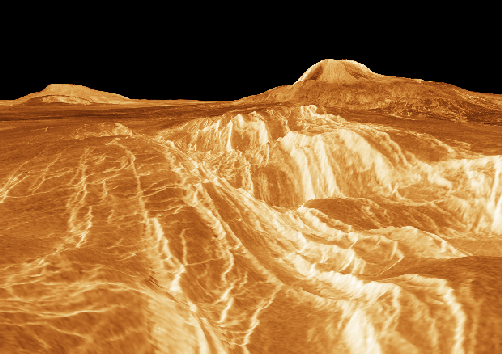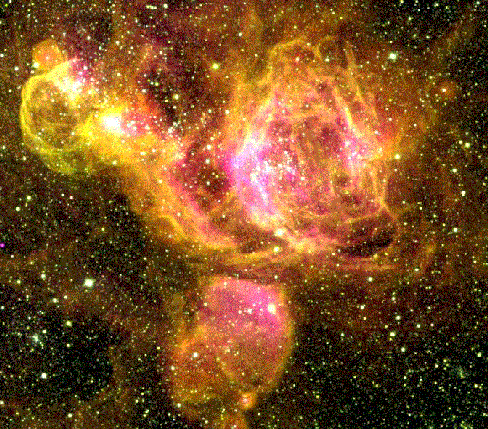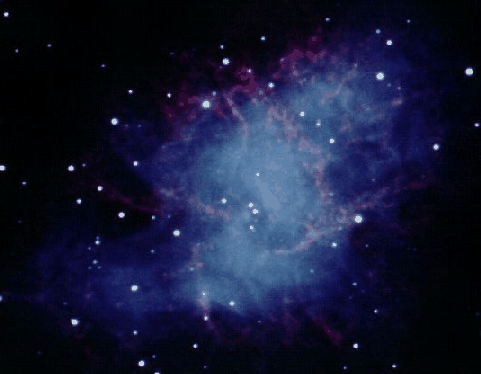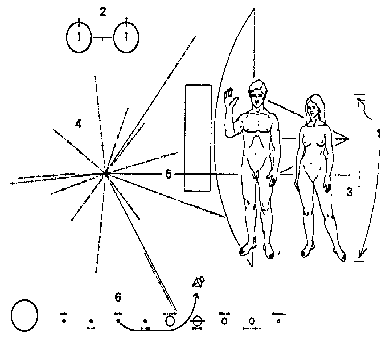NASA APOD #371-377
#371 Tomorrow's picture: June 24, 1996
“Color information from the Soviet Venera landers and radar data from the Magellan spacecraft were used to construct this striking perspective view of the Venusian landscape. (In this computer generated image, the vertical scale has been exagerated.) In the foreground is the edge of a rift valley created by faulting in the crust of Venus. The valley runs all the way to the base of Gula Mons, a 2 mile high volcano seen here on the right, some 450 miles in the distance. On the left is another volcano, Sif Mons. Using radar to pierce the dense clouds continuously shrouding the Face of Venus, Magellan was able to explore over 98% of the Venusian surface, revealing a a diverse and tantalizing topography."
Copyright: Public domain
#372 Tomorrow's picture: June 25, 1996
“Stars sometimes form in colorful ways. Pictured above is a small region in the nearby LMC galaxy where stars are forming. After a star is born, it may do several things to energize its immediate neighborhood. It may develop a strong wind which pushes away nearby gas; it may be so hot and intense that emitted light boils away nearby dust and gas, and it may be so massive that it soon goes supernova and catapults its elements back to the interstellar medium. Astronomers study regions like this - named DEM192 - to better understand how these and other processes proceed. This picture is a composite of three separate photographs, each sensitive to only one specific color of light - a color that distinguishes a specific chemical element."
Copyright: Public domain
#373 Tomorrow's picture: June 26, 1996
“French astronomer Charles Messier was born on June 26, 1730. Inspired by childhood sightings of comets and a solar eclipse visible from his home town of Badonvillier, he became an astronomer and comet hunter who kept careful records of his observations. While hunting for comets in the skies above France he made a now famous list of the positions of about 100 fuzzy, diffuse looking objects which appeared at fixed positions in the sky. Although these objects looked like comets, Messier knew that since they did not move with respect to the background stars they could not be the comets he was searching for. These objects are now well known to modern astronomers to be among the brightest and most striking nebulae, star clusters, and galaxies. Objects on Messier's list are still referred to by their "Messier number". The first object in his catalog, M1 pictured above - also known as the Crab Nebula, was recorded during his search for the return of comet Halley in 1758. Messier died in his home in Paris in 1817."
Copyright: Public domain
#374 Tomorrow's picture: June 27, 1996
“NASA's robot spacecraft Galileo began its long voyage to Jupiter in October of 1989. In December of last year it arrived in the Jovian system, beginning its unprecedented, detailed exploration by dropping a probe into the gas giant's atmosphere. By early this morning it will have accomplished another milestone in its ambitious mission. Now in orbit around Jupiter, Galileo will make its first close flyby of Ganymede, Jupiter's (and the solar system's) largest moon at 2:29 a.m. EDT. As planned, approaching to within 524 miles, it will make a series of high resolution images of the surface which will reveal features as small as 33 feet across. This close-up color image from the Voyager 2 flyby in 1979 previews sights Galileo will see in greater detail. Showing features as small as 3 miles across, it reveals a variety of terrain on Ganymede's icy surface, including impact craters with bright rays and long strips of light grooved structures suggesting large scale motions of the frozen crust. Galileo's flyby images will be stored onboard for playback and should be available during the week of July 10."
Copyright: Public domain
#375 Tomorrow's picture: June 28, 1996
“Researchers believe that the faint reddish smudge indicated by the arrow in the image above is a candidate for the most distant known galaxy which may have existed only a few hundred million years after the Big Bang. The image is part of the Hubble Deep Field, the Hubble Space Telescope's deepest yet picture of the Universe. Made in December 1995 by staring for ten consecutive days with the Hubble, astronomers have been intently studying the resulting deep field image filled with remote galaxies for clues to what galaxies and the Universe looked like in the distant past. While nearby galaxies are easily detected in the image - some seen here have visible elliptical and even spiral structures - the most distant (and therefore oldest) galaxies must be identified by examining their appearance in different wavelengths of light. Based on this technique, six of the most distant galaxies in the Deep Field appear to be farther away than even quasars."
Copyright: Public domain
#376 Tomorrow's picture: June 29, 1996
“Launched in the summer of 1977, NASA's Voyager 1 and 2 spacecraft are now over 4.5 billion miles from the Sun. Still operational, the Voyagers are being tracked and commanded through the Deep Space Network. Having traveled beyond the outer planets, these remarkable spacecraft are only the third and fourth human built artifacts to escape our solar system, following in the footsteps of Pioneer 10 and 11. A 12-inch gold plated copper disk (pictured) containing recorded sounds and images representing human cultures and life on Earth, is affixed to each Voyager - a message in a bottle cast into the cosmic sea. The recorded material was selected by a committee chaired by Carl Sagan of Cornell University. The disks are intended to be played like a phonograph record at 16 and 2/3 revolutions per second. Cartridge and needle are supplied, along with some simple diagrams (visible above) which represent symbolically the spacecraft's origin and instructions for playing the disk. The exotic construction of the disks should provide them with a long lifetime as they coast through interstellar space. The two spacecraft will not make a close approach to another planetary system for at least 40,000 years."
Copyright: Public domain
#377 Tomorrow's picture: June 30, 1996
“Launched in the early 1970s Pioneer 10 and 11 were appropriately named - becoming the first spacecraft to travel through the asteroid belt, first to fly by Jupiter and Saturn, and the first human artifacts to venture beyond the solar system. Now coasting through interstellar space, they carry with them greetings in the form of a gold anodized plaque with symbolic drawings as illustrated above. The male and female figures are drawn to the same scale as the Pioneer spacecraft shown behind them. Immediately to the left is a map of the position of the sun with respect to nearby pulsars and the center of the galaxy while below is a drawing of the solar system indicating the planet of origin. In the upper left is a schematic of two fundamental states of the hydrogen atom. These diagrams along with other details of the plaque were designed by Carl Sagan of Cornell University and are intended to be decipherable by spacefaring extraterrestrial civilizations."
Copyright: Public domain
Upvote! Resteem! Comment! As you like it! Thank you for attention!






